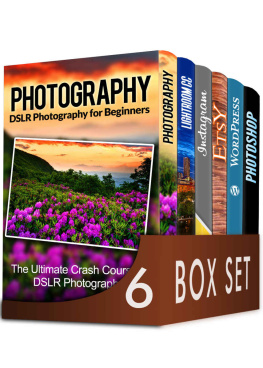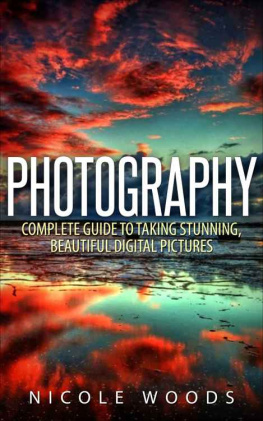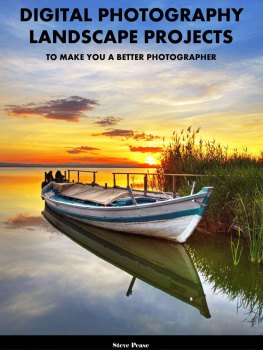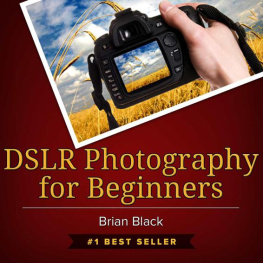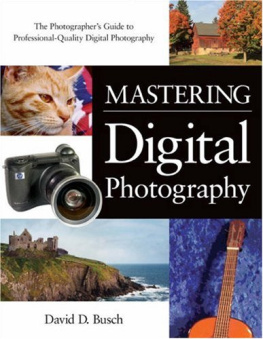Jim Hamel - Getting Started in Photography: A Complete Beginners Guide to Taking Great Pictures
Here you can read online Jim Hamel - Getting Started in Photography: A Complete Beginners Guide to Taking Great Pictures full text of the book (entire story) in english for free. Download pdf and epub, get meaning, cover and reviews about this ebook. year: 2016, genre: Romance novel. Description of the work, (preface) as well as reviews are available. Best literature library LitArk.com created for fans of good reading and offers a wide selection of genres:
Romance novel
Science fiction
Adventure
Detective
Science
History
Home and family
Prose
Art
Politics
Computer
Non-fiction
Religion
Business
Children
Humor
Choose a favorite category and find really read worthwhile books. Enjoy immersion in the world of imagination, feel the emotions of the characters or learn something new for yourself, make an fascinating discovery.

- Book:Getting Started in Photography: A Complete Beginners Guide to Taking Great Pictures
- Author:
- Genre:
- Year:2016
- Rating:5 / 5
- Favourites:Add to favourites
- Your mark:
- 100
- 1
- 2
- 3
- 4
- 5
Getting Started in Photography: A Complete Beginners Guide to Taking Great Pictures: summary, description and annotation
We offer to read an annotation, description, summary or preface (depends on what the author of the book "Getting Started in Photography: A Complete Beginners Guide to Taking Great Pictures" wrote himself). If you haven't found the necessary information about the book — write in the comments, we will try to find it.
Jim Hamel: author's other books
Who wrote Getting Started in Photography: A Complete Beginners Guide to Taking Great Pictures? Find out the surname, the name of the author of the book and a list of all author's works by series.
Getting Started in Photography: A Complete Beginners Guide to Taking Great Pictures — read online for free the complete book (whole text) full work
Below is the text of the book, divided by pages. System saving the place of the last page read, allows you to conveniently read the book "Getting Started in Photography: A Complete Beginners Guide to Taking Great Pictures" online for free, without having to search again every time where you left off. Put a bookmark, and you can go to the page where you finished reading at any time.
Font size:
Interval:
Bookmark:
A Complete Beginners Guide to Taking Great Pictures
by Jim Hamel
www.OutdoorPhotoAcademy.com
Copyright 2016 James W. Hamel
All rights reserved. No part of this book may be reproduced in any form without written permission from the author, except that reviewers may quote brief passages.
All photography James W. Hamel
Publishing Services Provided by

Archangel Ink
Table of Contents

Grapevine Sailboats
Exposure: Shutter Speed 1/10 second; Aperture f/11; ISO 100
Focal Length: 105 mm
Location: Silver Lake Marina, Lake Grapevine, Texas
I have spent much of my time in recent years teaching and writing about photography and youll read a lot more about my website Outdoor Photo Academy throughout this book. As I answered a lot of questions about photography, I began thinking that it would be nice to have a basic guide of photography information all in one place, so I could just point my readers to it and get them up to speed quickly. Frankly, that need surprised me, because it seems like there are a million intro to photography books out there. Why would I need to add to that list?
I thought about it and realized that what I want for my readers is something a little different than the standard introduction to photography. It seems like most others simply introduce you to photography concepts and then provide you with some different options and ways of doing things. Many do an admirable job of that, and I have enjoyed many such books over the years. But it always seems to me that they are afraid of appearing pushy so they never actually say, Here is what you should do. In other words, they might work through all the different kinds of cameras, but never say, Heres what you should get. They might talk about the ways you can set up a camera, but rarely do any of them say, Heres how you should do it. They might show you all sorts of different compositional elements, but not say, Here is a process for composing your photos. And so on.
If you came over to my house and said Jim, how can I take better pictures? would I say to you, Well, here are some principles of photography and a bunch of options? No. Frankly, I dont think anybody would do that. Instead, I would say, OK, let me show you how I do it and then Id proceed to show you that. Thats what everybody does, so why should we do it differently in a book?
Therefore, instead of options and principles, Im going to take you down one path. Im going to tell you exactly what you should do. Im going to tell you what type of camera to buy with a few specific models. Then Im going to tell you exactly how to set it up. After that, Im going to tell you how to expose pictures properly without resorting to automatic mode. I will show you how to choose good subject matter and also how to compose your pictures. Finally, Im going to tell you how you should process the photos. Ill walk you through the entire process. We will try to get as far down the path as we can in as short an amount of time as possible.
Now, does that mean I expect you to slavishly follow my approach? Obviously not. I assume that you will take this information and incorporate it into what you already know, using some and discarding some. Just take this information, digest it, and then go off and do it your own way.
This process will help you take much better pictures in a very short period of time. You will not have to muddle through a bunch of options. Just do it this way and watch your pictures get better.

Chicago River
Exposure: Shutter Speed 30 seconds; Aperture f/13; ISO 200
Focal Length: 20 mm
Location: Chicago, Illinois
Why should you bother doing this at all? Because taking great pictures is worthwhile no matter who you are. The process is fun, and the camera acts as a passport to take you to see all sorts of interesting people and places. It also provides you with little mementos of the great times youve had and places youve visited. Youll end up with a tangible thing, which might be as simple as something you post to Facebook or a picture in a frame on your desk or a print hanging on a wall in your home or someone elses home.
No matter what you end up with, remember that pictures are the things that everybody says would be the first things they would save in case of a fire. If these are the things that are the most precious items in the world to most of us, we might as well learn how to make them as good as possible.

Portland Head Light
Exposure: Shutter Speed 20 seconds; Aperture f/11; ISO 100
Focal Length: 24 mm
Location: Portland, Maine
First things first: You need to be set up with a camera and lens to do photography. There is no sense talking about anything else until you have that squared away. Plus, cameras and lenses are what everybody wants to talk about. By a million miles, the most common question I get from all new photographers is some version of Which camera/lens should I buy? So lets get into it right away.
Here is what you should buy as a photographer just starting out. You actually have a few options here:
Option 1: DSLRs

The traditional workhorses of quality photography are or Digital Single-Lens Reflex cameras, and you will not go wrong with one of these. The first question will be which brand to get, and here you should stick with either Canon or Nikon, which have been the gold standard of DSLRs for many years. It doesnt matter which one you choose as it is like deciding between Home Depot and Lowes they are basically the same thing but set up a little differently.
Within the Canon or Nikon brands, get the cheapest, entry-level DSLRs available with the kit lenses. In the Canon world that is presently the Canon T6i (or 750D outside the US), and in the Nikon world it is the Nikon D5500. In either case, you can get them with a kit lens, which is an 1855 mm f/3.55.6 lens. This will cost you about $850 in all, no matter which one you choose.
Option 2: Mirrorless Cameras

If the size of the camera is a big issue for you and you want the smallest camera possible, either because you are getting on in years, you want to carry the camera in your purse or large pocket, or are hiking many miles a day, get a . They are very small and the quality has improved markedly in recent years so that they are very close, if not equal, to that of DSLRs. Because of their small size, they are also a little cheaper.
If you decide to buy a mirrorless camera, look no further than Sony. Specifically, get the Sony A6000 and the 1650 mm kit lens. When this camera was introduced, it sold for $800 with the kit lens, but it has been on the market a while so the price has dropped to about $650 at the time that I am writing this.
Font size:
Interval:
Bookmark:
Similar books «Getting Started in Photography: A Complete Beginners Guide to Taking Great Pictures»
Look at similar books to Getting Started in Photography: A Complete Beginners Guide to Taking Great Pictures. We have selected literature similar in name and meaning in the hope of providing readers with more options to find new, interesting, not yet read works.
Discussion, reviews of the book Getting Started in Photography: A Complete Beginners Guide to Taking Great Pictures and just readers' own opinions. Leave your comments, write what you think about the work, its meaning or the main characters. Specify what exactly you liked and what you didn't like, and why you think so.

